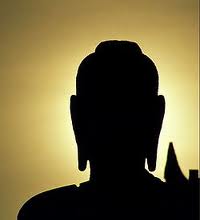I remember when I was a child a particular punishment my father used to mete out to my sisters and me. It involved kneeling. That was it— just kneeling, for prolonged periods of time, straight up, head down, like you were at Mass but you weren’t in a church you were in your living room, paying the price for some transgression or in order for you to confess to one. Hours passed (probably minutes) while I knelt on the powder blue rug in the room just off the foyer, people entering the front door, pausing, then passing by. I would pretend to be at prayers, just to mitigate the humiliation. I don’t know the provenance of this particular penance (was it Chinese? Catholic?) but I remember it being agony.
It’s interesting that, four decades later, I find myself in the same position. Willingly.
Just got back from a meditation retreat at the Zen Center of Los Angeles. It was an all-day session, from 5:45 AM to 5 PM. There was walking in a circle meditations (kinhin), mindful work, chanting, and silent meals, but mostly just sitting/kneeling. LOTS of sitting/kneeling. It may sound simple, but in reality all that sitting absolutely still is pretty rigorous. The last time I did a retreat (2-day) sitting cross-legged on a cushion I paid for it with six months of rehab for a bulging lumbar disc. This time I swallowed my ego and alternated kneeling on said cushion and sitting in a chair. Big difference.
The purpose of all of this silent sitting (zazen) is to cultivate Samadhi, an intense state of concentration. The whole day is designed for this purpose. We go the entire day observing a Great Silence, at meals, in between sessions, even in our rooms. No text messages. No ipods. Normal civil interactions are dropped. Our gaze is always lowered, to avoid intruding into the Samadhi of another. The day is minutely structured, guided by the chime of bells, the clack of wooden blocks, the strike of a drum, so that few words of instruction are ever needed.
Those who look fondly upon Catholic rituals would be right at home here. Ever action you take during the day is according to ritual. The idea, in theory, is that if every move is according to a plan, you don’t have to think about what you’re going to do next, what kind of interaction you’re going to have. And this opens up space in your mind. It eliminates some of the chatter that typically occupies your brain.
And what does one do with all that wide-open, new-found retail space? Well, nothing, really. Or, No-thing. According to my limited understanding, all of this Silence gives you a chance to simply abide in the present, without having to worry about what will become or what just happened. You’re not trying to eliminate, or stop, thoughts; you’re just trying not to become enmeshed in them. You observe the thoughts that arise and let them pass, without becoming attached. You strive for non-reaction.
That’s the theory, anyway. In practice, I attached myself to plenty of thoughts.
Meal were particularly challenging. We ate according to the tradition of Oryoki, the three-bowl eating practice of Zen Buddhist monasteries. It’s a fascinating ritual but maddeningly complex if you’re wanting to, you know, actually just eat something. Every move is orchestrated, from the precise laying out of your place setting to serving the food to the length of the eating itself. Everyone starts and finishes eating at the same time and, an everything in your bowl must be finished. No waste. Even the hot water we use to clean our bowls at the table is ceremoniously poured into a large bowl and used to water the garden. You eat to simply nourish your body for the sitting to come. Everything is done swiftly, efficiently, and, except for the prayers, in total silence.
A video of the laying out of the bowls.
What to do, then, when a giant bowl of tofu comes hurtling down the long table in your direction?
As some of you may know, I have had a lifelong aversion to tofu AKA bean curd AKA that-slimy-mushy-stuff-always-found-at-family-banquets. I find it similar, in look and texture, to what I imagine the flesh of drowned sailors to be. Nausea-inducing. And here was tofu, huge squares dotted with minced green onion and bathed in soy and sesame, that was the main offering for lunch. I was pretty sure that I couldn’t simply refuse it; I had to put something in my main Buddha bowl. According to tradition, the person on the opposite side of the table serves me. How to tell her to go easy on the serving? During the chanting of the names of the Buddhas I’m desperately trying to figure out a way to signal to the woman across from me that I only want a token portion. I know the hand gesture for “no more,” but what’s the hand gesture for “more than one cube and I’m gonna puke”?
The bowl nears. We bow to those passing it to us. My server digs the serving spoon in. I raise my Buddha bowl… and in a last-minute gambit, I try to signal “just a little bit” with my thumb and forefinger, realizing belatedly that that is also the signal for “just a little more.” SHE PLUNGES THE SPOON DEEPER. The spoon emerges from the bowl, mounded high with glistening cubes. About nine of them plop into my Buddha Bowl. I almost flinch. Nine! Buddha bowl very unhappy. I was sitting next to the Sensei’s assistant, so no hiding it in the napkin (which had to be folded perfectly at the end of the meal anyway). I managed to get it all down by pretending I was in “The Amazing Race” finishing an eating challenge. Do it for the million bucks! Do it for the million bucks! Hmm… not really cultivating a Buddha mind, exactly…
One day is almost too short a period for this kind of practice; by the end of the day I felt like I was ready to begin. I did have some moments of clarity, though, enough to jump-start my daily practice. And though I never got to talk to my fellow black-garbed participants or even get a good look at their faces until after the day was over, I really felt like I had shared an Experience with them all. It was an Inward Bound.
My favorite moment was in the early morning. It was so quiet; even the birds hadn’t woken. The distant drone of traffic could have been waves on a far-off shore. At this first sitting of the day we face each other in the meditation hall instead of the usual wall-gazing. We’re all perfectly still, frozen in our postures, like statuary in the dim light. Our shared dharma stretches between us like a sheet. We are Buddhas, patient and serene, awaiting the coming of the day.
The thought manifests as the word,
The word manifests as the deed,
The deed develops into habit,
And habit hardens in character,
So watch the thought and its ways with care,
And let it spring from love,
Born out of concern for all beings…
As the shadow follows the body,
As we think, so we become.
—The Dhammapada







So sorry about your tofu experience. I think you could find a way to cast your ability to finish it in the "zen" experience. I know that I cannot quiet my mind for an entire day, so I applaud you for trying it. BTW – I would pay good money to see Doug try this. Hee hee.
Thanks for the "drowned sailor flesh" comparison. Now I'm not sure I'll ever be able to eat tofu again. And I even LIKE it.
It sounds like a wonderful time! As for the tofu? Well, it was an exercise on "attachment and aversion." Contemplate that, grasshopper.
Jesus makes you eat crackers.
Buddha makes you eat tofu.
Potato, potahto.
[…] of sitting meditation from 9-4. What makes it different from daily meditation practice or even the meditation retreats I’ve attended is that there is no structure. No bells to tell you how long you’ve been sitting, no formal […]